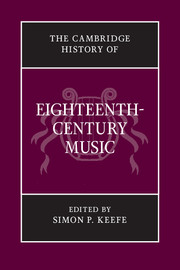Book contents
1 - The musical map of Europe c. 1700
from PRELUDE
Published online by Cambridge University Press: 28 March 2011
Summary
At the start of the eighteenth century, Europe displayed a panorama of musical styles and an array of performing opportunities. When Wolfgang Caspar Printz described a musical tour through central Europe in his Phrynis Mytilenaeus (1696), his account consisted of the names of leading musicians in each place. Certainly the achievements of individuals were important; but equally significant were the environments in which they worked. As Charles Burney wrote: ‘Music, indeed like vegetation, flourishes differently in different climates; and in proportion to the culture and encouragement it receives.’ This chapter outlines some of the ‘different climates’ encountered by early eighteenth-century musicians, ranging from courtly patronage to the entrepreneurial possibilities in large towns. The connection between music and place is also seen in the national styles of composition and performance that were central to musicians’ vocabulary in the period.
A crucial factor in the awareness of music’s geography was the growth in international travel by the eighteenth century. Increasing numbers of musicians went abroad to work or to learn foreign styles. Aristocrats and connoisseurs also journeyed, particularly on the Grand Tour that English and German tourists took to France and Italy. For Johann David Heinichen, travel was a way to gain musical experience and nurture that ‘rarest jewel’, good taste. ‘Why do we go through effort, danger and expense to travel around from nation to nation. . .?. . . Simply and solely to develop our good taste.
- Type
- Chapter
- Information
- The Cambridge History of Eighteenth-Century Music , pp. 1 - 26Publisher: Cambridge University PressPrint publication year: 2009



